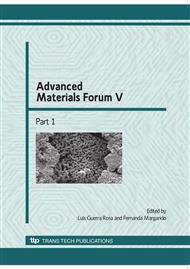p.155
p.161
p.171
p.177
p.184
p.192
p.198
p.206
p.214
The Properties and Structure of Infiltrated High Speed Steel-Tungsten Carbide-Copper Composites
Abstract:
The aim of the present study was to produce high speed steel – tungsten carbide – copper composites, which should have acceptable density, wear resistance and good sliding prosperities. Various amounts of WC powder were added to the HSS powder prior to compaction. The following compositions were investigated: 100% M3/2, M3/2 + 10% WC and M3/2 + 30%WC. The mixtures were prepared by mixing for 30 minutes in the 3-D pendulum motion Turbula® T2C mixer. Then the powders were cold pressed in a rigid cylindrical die at 800 MPa. Both green compacts and pre-sintered compacts (pre-sintering condition: 1150°C in vacuum for 60 minutes) were infiltrated with copper. The whole infiltration process was carried out in vacuum better than 10-3 Pa. Pre-weighed preforms of copper were carefully placed on top of the rigid skeletons in which porosity were predetermined, heated up to 1150°C, subsequently held at temperature for 15 minutes, and cooled down with the furnace to the room temperature. The dilatometer was used to detect some reaction in the sintering. The changes in as pressed and as sintered density, hardness, bending strength and tribological properties are discussed in this work.
Info:
Periodical:
Pages:
184-191
Citation:
Online since:
January 2010
Authors:
Keywords:
Price:
Сopyright:
© 2010 Trans Tech Publications Ltd. All Rights Reserved
Share:
Citation:


